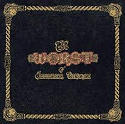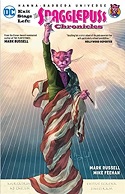Notes On A Story I’m Writing…(continued)
So I have my two main characters, Terry and Jeff, a twenty-something gay couple, plus several other supporting characters all involved in this supposed ghost hunt arranged by a cheap reality TV show. Neither Terry nor Jeff believe in ghosts. Terry’s there because he wants to investigate the goings on at this supposedly haunted place because it’s tweaked his curiosity. He thinks ‘supernatural’ is a meaningless term, and that everything has a logical reason. And for the five hundred bucks the TV show routinely offers to anyone who can spend the night in their haunted place du jour, because his spending habits have caused friction in the relationship. Jeff gets involved because so many other local ghost hunters dropped out as soon as they laid eyes on the abandoned office building where this all happens, and the producer offers him a slot in it at the very last minute when he shows up with Terry. And because he’s afraid his man is walking into trouble.
So the cast includes true believers, a couple non believers, and the scam artists working the reality cable TV show. I’m finding that the more I work with the background characters the more I come to know them, the more I see how important their individual background stories are to the story I’m telling. Which isn’t about ghosts.
The thing about ghost stories, the good ones anyway, is the stories aren’t actually about ghosts. The ghosts are a catalyst for the events in the story, which is about the people. And I’m telling story two stories really. One is the love story I never got enough of, especially when I was younger. The other is a morality play I’ve thumped on many times in many different ways.
I like writing these stories the way Ken Burns’ Civil War series did about the war, where you have the big players like Lincoln, Grant, Lee, and Jefferson Davis, but he moves the story along with entries from the diaries of everyday Americans who were caught up in it. It is in their stories you get your best sense of what that war was about, and why it had to be fought.
Ayn Rand (who yes I’m embarrassed now to admit I have read) had her grand larger than life story embodied by her larger than life heroes. It was a mistake, but probably one she couldn’t help making because she was what she was, namely a worshiper of strongmen. Yes she had her secondary characters, Eddie Willers, and that too beautiful not gay could not possibly be gay brakeman we first meet whistling the tune to Hally’s fifth concerto. He never even gets a name. But the story does not live in any of them.
That’s the problem. She almost gets it, when she relates in a series of quick sketches after the John Galt speech, how everyone knew after they heard it who would be going on strike and disappearing next, and who would not. But she doesn’t tell those stories. She isn’t interested in them. The everyday people who stand up to crooks and bullies are not her heroes. But they’re mine.
Tolkien got it when he wrote, “Some believe it is only great power that can hold evil in check, but that is not what I have found. It is the small everyday deeds of ordinary folk that keep the darkness at bay. Small acts of kindness and love.”
I submit that those small everyday deeds Are the great power. And when, in your art, you thump your pulpit about it, you can draw in large bold strokes the morality sermon at the heart of it, but it’s in the detail where you show how it lives in your characters and your reader sees it.
In the background of my story are the corrupt billionaires and crony capitalists who built the Palmer Building. But they never actually appear in the story. I’m pulling a switch on the Ayn Rand method, where my larger than life characters are deep in the background and it’s the street level people who are my main focus. I tell the reader about all the thievery and grift that built the Palmer Building, but what I put front and center is a reality TV producer who gets his kicks, and his money, manipulating people, because it amuses him. Everything about his TV show is faked, simply to attract a gullible audience and a few true believers, and this time a couple young skeptics, all of whom he uses purely for entertainment. Behind their backs he’s sneering at them. He’s a dime store swindler, but no different in any meaningful way from the ultra rich crony capitalists who built the location of his current bit of flimflam.
Only this time the haunting is real. The final boss, as the gamers say, is waiting for him, and for them all. Something deeper and darker than anything even the rich and powerful could manage, let alone the cheap and contemptuous: and different metals behave differently in the fire. Which I think is a better story than simply spilling a lot of blood and guts and cheap scares, Or straight up sermonising.
Jacob Bronowski once said that art does not set out to preach but to shine a light, and that “the values by which we are to survive are not rules for just and unjust conduct, but are those deeper illuminations in whose light justice and injustice, good and evil, means and ends are seen in fearful sharpness of outline.”
That was Rand’s failing. She seemed constitutionally incapable of just showing the reader the values she’s going on about. She has to hit them over the head with them. Over and over again. That John Galt speech near the end was, in its comprehensive pontification, an abject failure of artistic nerve. By that point after being hit in the head with it over and over and over in a Russian sized thousand page plus novel the reader should have bloody hell already got the message. But the reader could not be trusted to see. Probably because the light was so dim.
I submit that where you really see those deeper illuminations is in those small everyday acts of kindness and love. And in the quiet courage and inner strength those things arise from. That is the glue that holds civilization together, and keeps the darkness at bay. The world does not need Atlas, it can hold itself up. One small act of kindness and love, one small act of courage, at a time.







































